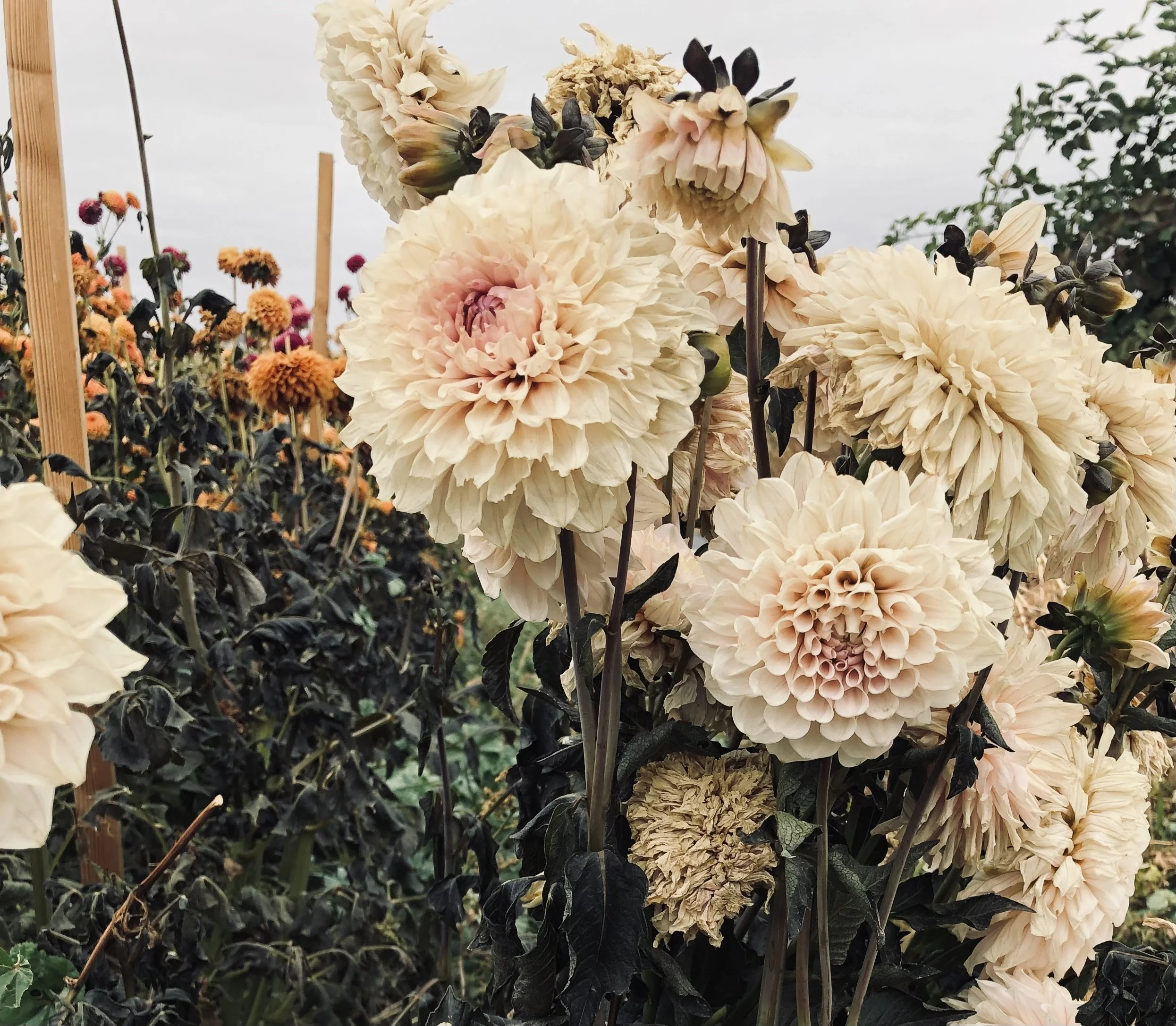Winter in the Garden
Winter is a welcome time for me in the garden. People often ask when the threat of first killing frost is on the horizon- are you going to miss your garden? I bet you get sad when you see the frosted drooping dahlias and black tomato plants! The honest answer is no, I do not. Of course it would be nice to have fresh basil for a salad or the big juicy heirloom tomato year round, but then I think it may not feel as special. When the killing frost finally comes- I am ready for it.
Spring
In Spring, there is nothing like green seedlings popping out of the ground, the first robins chirping and building their nests (not in my garden shed please), the scent of lilacs and hyacinth, and the bursting propagation room full of seedling trays.
In spring there is anticipation, hope, days with time still to dream, sunshine, and inevitably- lots of wind.
Nigella loves cool spring temps
Summer
Summer brings the rush of garden chores as beds need finished prepping and plants put into the ground. Each plant has specific needs and wants and I have to pay careful attention to this if I want it to get a good harvest. Summer usually brings cool, brisk nights in June which can quickly turn to sweltering heat by late June early July.
As it gets hot we spend more time in the mountains- camping, fishing, hiking, swimming and rafting the rivers around here we are blessed with. The garden irrigation is on a timer and can be self-sufficient when we are traveling in the summer.
We grow a lot of chiles
Fall
Early fall brings heavy harvests, and the best time of year to pick peppers, tomatoes, basil, and the myriad of cut flowers we grow- especially dahlias. Dahlias are at their peak during early fall, as temps drop and their colors get more saturated- they become just stunning.
The air gets crisper, time for hunting and fishing picks up again, and I am scrambling to get all of the harvesting and preserving done. At this time I often have counter tops so full of food I just have to do SOMETHING to put the food away- even if just chopping and freezing. And by the end of many weeks straight of feeling the preserving pressure from plums to berries, peppers and chiles, tomatoes, basil, parsley, dill, lots of onion varieties, garlic, okra, potatoes, kale, lettuce, peas, beans, chives, broccoli, carrots, cutting flowers and medicinal and culinary herbs….you can begin to see why I humbly welcome the next season.
If all of the harvest/ preservation wasn’t enough we have to turn beds as the crops peter out. Turning beds means pulling old plants or simply cutting at the surface and leaving their roots in the soil as biomass to decompose and turn into soil organic matter. After the plants are removed, compost is laid, sometimes a granular organic fertilizer, and then a thick layer of mulch (organic/seed-free straw, leaves, or pine needles). This is important to let your amendments sit over the winter to help restore and build soil health.
Black dahlia foliage= heavy frost
First Frost
First hard frost is in the forecast and I get giddy- the season has ended and there are always new challenges and discoveries every year. I do not race out and cover my plants in bed sheets or plastic- because at my house it is good riddance!! The change of seasons is something we are attuned to biologically and the shift from fall to winter in these parts is often the most subtle. Without the extreme heat of summer, bracing winds of spring, and more increasingly smoke filled skies of early fall, the welcoming of winter has a slow grace to it.
Birds change migration, the clouds look and smell different, and a different kind of hope is in the air. Hope for quiet, health, time to rest and spend quality time with those you love with lack of an agenda. Winter is food for our souls and I highly recommend the book Wintering by Katherine May if you haven't read it.
Winter
Winter chores for the garden include compost laying in the garden after beds are turned, mulch laying with leaves and straw, leaf piles for compost (see recipe below), planting and mulching garlic, and tending to the greens bed I hopefully planted in August, by keeping it mulched and covering when cold temps are here to stay. This bed usually includes lettuces, arugula, spinach, radish, mustard greens, carrots and beets.
If I can recommend one thing to do in fall besides cook with your garden produce, is to plant a fall/winter greens bed. It is so awesome to go outside in the snow, lift the row cover, and pick your own salad in the dead of winter when your body is craving those nutrients.
Leaving the garden ‘unkempt’
I will often leave many of my crops intact over the winter, to provide habitat and food for birds and beneficial insects. These are usually perennials or crops that have notable seeds like the broomcorn, sunflowers, dill, and amaranth that the birds love. The perennials and grasses stay put year after year so no need to prep the bed and it looks pretty in the snow and frost.
The crops I definitely pull and remove all plant material include annuals like tomatoes, peppers, beans, cukes, and squash. The squash plants I will add to the burn pile if we had a bad squash bug year, and note that cleaning up the garden bed in the area where squash bugs had inhabited that year is recommended to prevent spaces for them to overwinter. I will also add the disclaimer that whatever you do to prevent squash bugs won’t work LOL. Can you tell that I am squash bug-bitter?
Leaving some plants intact over the winter is good for the ecosystem
Time for rest
Whether you garden or not, please take this season to rest. Our bodies, minds and souls need it and our nervous system needs it more than ever. This is a great time to take up new self-care routines and practice the art of saying no, before the holidays start. We can’t do everything and the sooner we realize that- the more enjoyable life will be.
Leaving you with a recipe for a leaf mulch compost pile.
Leaf Mulch Compost Pile:
Layer leaves 3 inches deep in a pile about 4x4 feet
Top with a layer of compost, native soil, or other organic matter like grass clippings
Continue to layer until you’re done (can be as big small as you want depending on material supply)
Spray with water until damp
Turn monthly OR Cover with a tarp and secure bottom with rocks, weights, or sandbags
Remove tarp in spring and use mulch where you see fit
This will result in a beautiful nutritious mulch for your crops (beware of walnut leaves as they emit a growth deterrent naturally).






